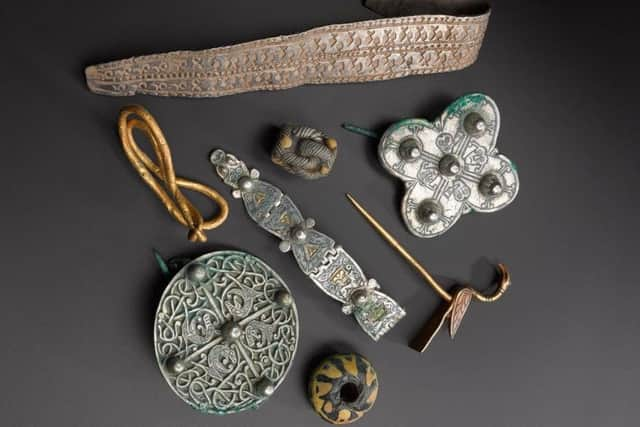Galloway Viking treasure hoard to tour Scotland
Experts have revealed that some of the objects hidden inside a pot found by a metal detectorist in a field in Kirkcudbrightshire may date as far back as 700 AD.
Some objects in Britain’s richest Viking-age collection are thought to originate from the Anglo-Saxon kingdoms, Ireland, the Holy Roman and Byzantium empires, the Middle East, the Baltic Sea and the Mediterranean.
Advertisement
Hide AdDetailed detective work on more than 100 objects found by Derek McLennan in the field will be carried out over the next year ahead of a major exhibition and £150,000 nationwide tour of what has become known as the “Galloway Hoard” from 2020-22.


The National Museum of Scotland, which raised £2 million to acquire the treasures from the Crown Estate, hopes the work will unlock secrets of the development of Scotland, England and Ireland, as well as previously unknown connections between people across Europe and further afield.
The work is also expected to “disrupt ideas” on the Vikings due to the way that the treasures were collected and protected inside the pot, which was buried around the 10th century and found in 2014.
Martin Goldberg, principal curator of medieval archaeology and history, said: “The next year is going to be quite intense and crucial. We carried out preliminary identification of material and looked at its broad historic context last year to help the campaign.
“We’re now trying to do fine-grained, detailed analysis, some of which is based on conservation work to improve some of the materials and stop corrosion. Some of the textiles are very rare. You can learn so much more about them now with the scientific techniques.
“We’ve been doing some CT scanning of metal objects which have textiles on them, because the textiles are obscuring them, but it’s not that one is more valuable than the other. We need to treat the textiles very carefully.
Advertisement
Hide Ad“We are accumulating evidence to build the case that some of the material goes back further than the 10th century. Some of the material has to be from the century before, but some of the objects might be from much earlier, maybe by couple of hundred more years.
“The hoard’s unusual feature, which really separates it from others, was that it had things in it which were curated, looked after, and carefully wrapped and packed.”After a six-month run at the National Museum in Edinburgh, the highlighs of the exhibition then visit Kirkcudbright Galleries before going on to the newly-refurbished Aberdeen Art Gallery and the McManus Art Gallery and Museum in Dundee, where they will be on display until August 2022.
Advertisement
Hide AdMore than 100 objects dating back to the 10th century - - were secured for the nation last year after a £2 million appeal.
The National Museum of Scotland has announced plans for a major exhibition, due to open in May 2020, devoted to the hoard, which landed enthusiast Derek McLennan with a £2 million windfall after he found the pot of treasure in 2014.
The tour It is hoped that extensive research into the Galloway Hoard will unlock secrets into the development of the modern nations of Scotland, England and Ireland, as well as previously unknown connections between people across Europe and further afield.
The first objects found included silver jewellery and ingots, arm-rings and a silver pendant Christian cross, depicting the Four Evangelists.
Buried underneath a layer of gravel were brooches, beads, a delicately crafted gold pin in the shape of a bird, and a small jar cut from rock crystal that may have originated in the Middle East. Some of the silver arm-rings have writing on them which signifies four named individuals.
The Scottish Government has agreed to pay £150,000 to help fund a tour after paying the same amount to contribute to a £2 million deal to the appeal to acquire the Galloway Hoard, which was confirmed last October.
Advertisement
Hide AdDr Gordon Rintoul, director of the National Museum, said: “The Galloway Hoard is an outstanding collection of Viking-age objects and our research into this find will transform current interpretation of Scottish history.
“I am delighted that thanks to generous funding from the Scottish Government we will be able to take the Galloway Hoard beyond our walls to museums across Scotland and ensure that the greatest possible number of people have the opportunity to enjoy this remarkable treasure.”
Advertisement
Hide AdScottish culture secretary Fiona Hyslop said: “The Galloway Hoard is one of the most important collections ever discovered in Scotland and I am pleased that this tour will allow for the hoard to be made available for the people of Scotland and our visitors in the years to come.
“The Galloway Hoard opens a window on a significant period in the history of Scotland and shows the important role that our archaeological heritage plays in Scotland’s culture.”
